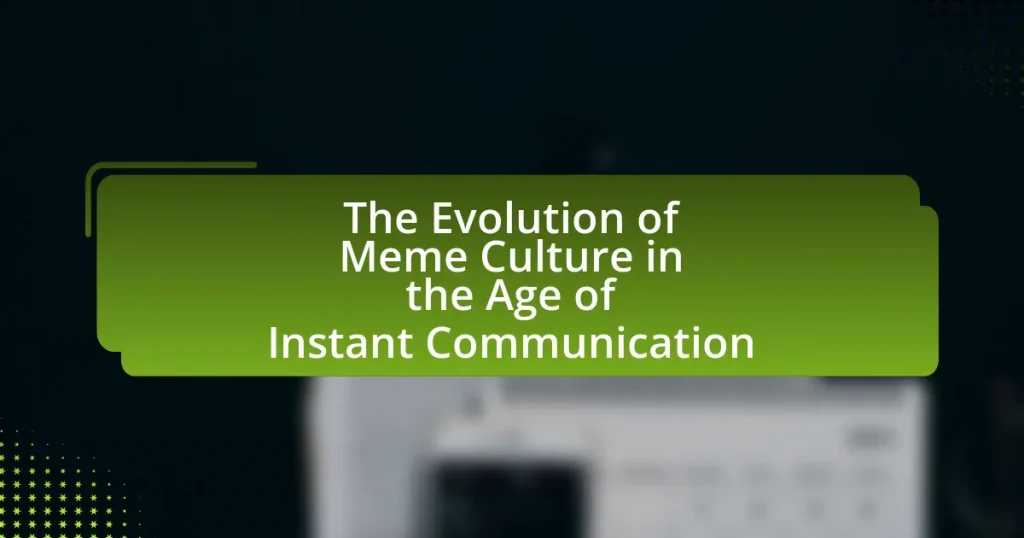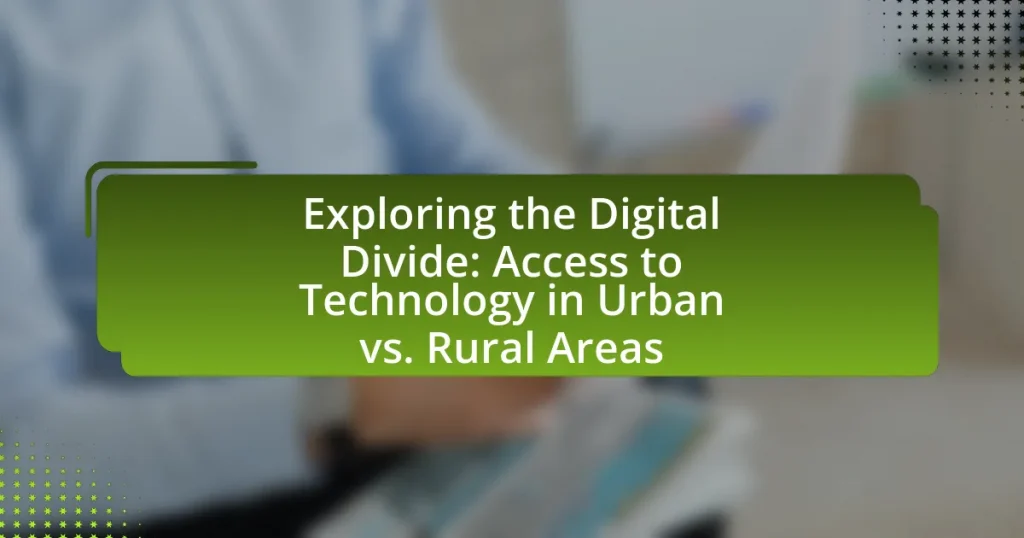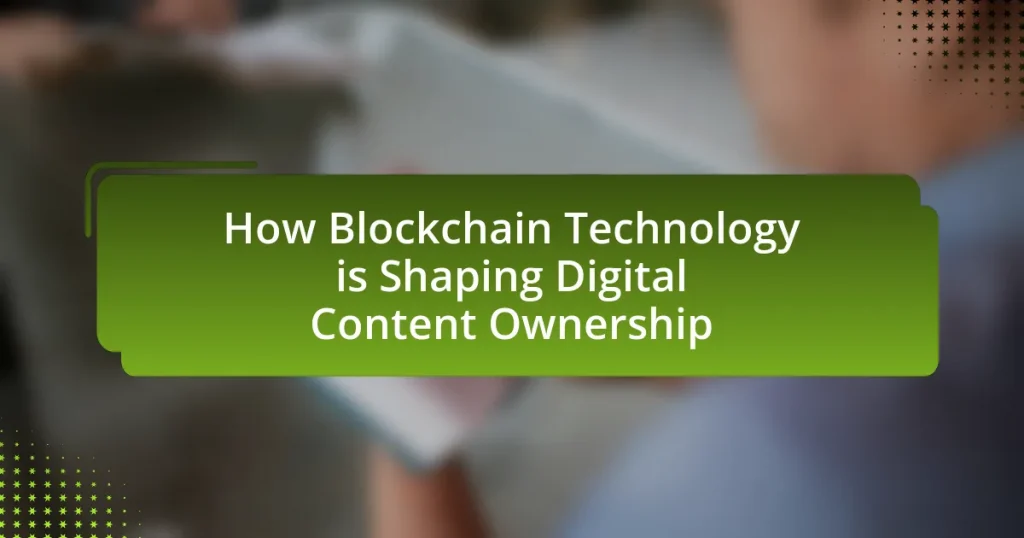The article examines the influence of podcasting on modern storytelling techniques, highlighting how this audio medium fosters intimate connections between storytellers and audiences. It discusses the transformation of storytelling through serialized narratives, immersive sound design, and diverse voices, which enhance engagement and accessibility. Key elements such as narrative structure, character development, and audience interaction are explored, along with the differences between podcasting and traditional storytelling formats. The article also addresses the challenges faced by creators and offers practical tips for effective podcast storytelling, while considering future trends and emerging technologies that may shape the medium.
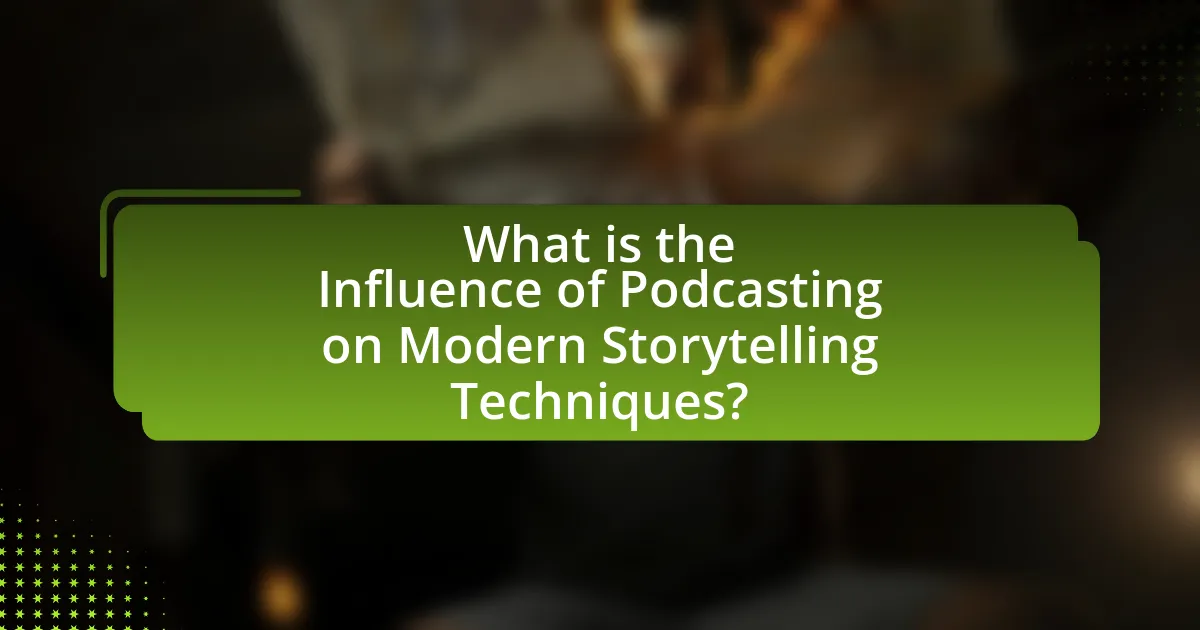
What is the Influence of Podcasting on Modern Storytelling Techniques?
Podcasting significantly influences modern storytelling techniques by enabling a more intimate and personal connection between the storyteller and the audience. This medium allows for serialized narratives, where stories unfold over multiple episodes, enhancing engagement and anticipation. According to a 2021 report by Edison Research, 41% of Americans aged 12 and older have listened to a podcast in the past month, indicating a growing audience that values this format. Additionally, the use of sound design and audio effects in podcasts creates immersive experiences that traditional storytelling methods often lack, allowing for deeper emotional resonance and a more vivid imagination in listeners.
How has podcasting changed the landscape of storytelling?
Podcasting has transformed the landscape of storytelling by democratizing content creation and enabling diverse voices to reach global audiences. This shift allows independent creators to share narratives without traditional gatekeeping, resulting in a broader range of stories that reflect varied perspectives. According to Edison Research, as of 2023, over 80 million Americans listen to podcasts monthly, illustrating the medium’s significant reach and influence. Additionally, the serialized format of many podcasts encourages deeper engagement with stories, fostering a sense of community among listeners who share similar interests. This evolution in storytelling not only enhances accessibility but also enriches the narrative landscape with innovative formats and themes.
What are the key elements of storytelling in podcasts?
The key elements of storytelling in podcasts include narrative structure, character development, sound design, and audience engagement. Narrative structure provides a framework that guides the story, often following a beginning, middle, and end format, which helps listeners understand the progression of events. Character development allows listeners to connect emotionally with the characters, making the story more relatable and impactful. Sound design enhances the storytelling experience by using music, sound effects, and audio quality to create an immersive atmosphere. Audience engagement is crucial, as effective storytelling in podcasts often involves direct interaction with listeners, fostering a sense of community and investment in the narrative. These elements collectively contribute to the effectiveness of storytelling in the podcast medium.
How do podcasts differ from traditional storytelling mediums?
Podcasts differ from traditional storytelling mediums primarily through their audio format and accessibility. Unlike written stories or visual media, podcasts allow for storytelling that can be consumed on-the-go, making them more convenient for multitasking audiences. Additionally, podcasts often feature a conversational tone and personal narratives, which can create a sense of intimacy and immediacy that is less prevalent in traditional storytelling forms. This format has led to a significant rise in popularity, with over 50% of the U.S. population having listened to a podcast as of 2021, indicating a shift in how stories are shared and experienced in the digital age.
Why is podcasting considered a powerful storytelling tool?
Podcasting is considered a powerful storytelling tool because it engages listeners through an intimate audio experience that fosters a deep emotional connection. This medium allows for nuanced storytelling, where tone, pacing, and sound design enhance the narrative, making it more immersive. Research indicates that 75% of podcast listeners feel a personal connection to the hosts, which amplifies the impact of the stories being told. Additionally, the accessibility of podcasts enables diverse voices and perspectives to reach a global audience, further enriching the storytelling landscape.
What emotional connections do podcasts create with audiences?
Podcasts create deep emotional connections with audiences by fostering intimacy and relatability through storytelling. The audio format allows listeners to engage with the content in a personal space, often leading to a sense of companionship with hosts and characters. Research indicates that 65% of podcast listeners feel a strong connection to the host, which enhances their emotional investment in the narrative. This connection is further amplified by the use of personal anecdotes and authentic voices, making the content resonate on a human level.
How does the audio format enhance narrative techniques?
The audio format enhances narrative techniques by utilizing sound elements such as voice modulation, music, and ambient noise to create an immersive storytelling experience. This format allows for emotional resonance, as the tone and inflection of a narrator’s voice can convey feelings and intentions that text alone may not express. For instance, research indicates that listeners are more likely to engage with stories that incorporate soundscapes, as these auditory cues can evoke vivid imagery and emotional responses, thereby deepening the connection to the narrative. Additionally, the flexibility of audio allows for varied pacing and rhythm, which can manipulate tension and release, further enriching the storytelling process.
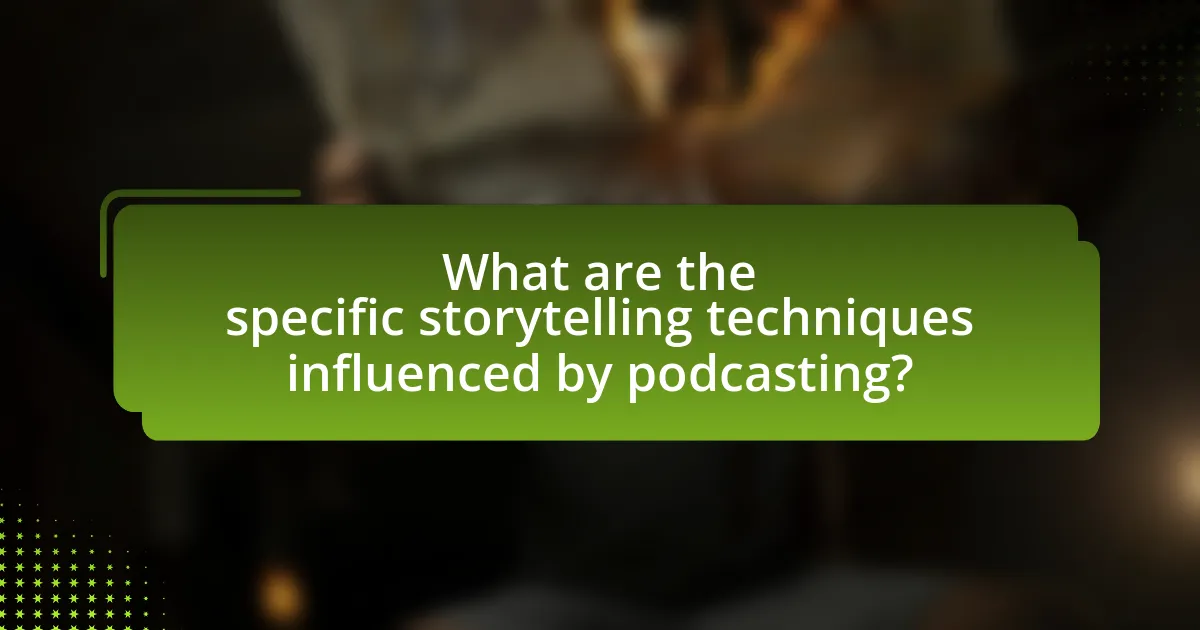
What are the specific storytelling techniques influenced by podcasting?
Podcasting has influenced several specific storytelling techniques, including serialized narratives, immersive sound design, and conversational storytelling. Serialized narratives allow for extended storytelling arcs, engaging listeners over multiple episodes, as seen in popular series like “Serial,” which captivated audiences with its unfolding mystery. Immersive sound design enhances the storytelling experience by using sound effects and music to create atmosphere and emotional depth, a technique effectively utilized in shows like “Welcome to Night Vale.” Conversational storytelling, characterized by a more informal and relatable tone, fosters intimacy and connection with the audience, exemplified by podcasts such as “The Joe Rogan Experience,” where discussions feel personal and engaging. These techniques reflect the unique audio medium of podcasting, shaping how stories are told and experienced.
How do narrative structures in podcasts differ from other formats?
Narrative structures in podcasts differ from other formats primarily due to their reliance on audio storytelling, which emphasizes auditory elements such as tone, pacing, and sound design. Unlike written formats, where readers can control the pace and revisit sections, podcasts guide listeners through a narrative in real-time, creating an immersive experience that leverages voice inflection and sound effects to enhance emotional engagement. This format often employs episodic storytelling, allowing for cliffhangers and serialized content that keeps audiences returning, a technique less prevalent in traditional literature or film. Additionally, podcasts frequently utilize interviews and conversational styles, which can create a sense of intimacy and immediacy, distinguishing them from more scripted or visual storytelling methods.
What role does pacing play in podcast storytelling?
Pacing is crucial in podcast storytelling as it dictates the rhythm and flow of the narrative, influencing listener engagement and emotional response. Effective pacing allows for the strategic placement of tension and release, which keeps the audience invested in the story. Research indicates that well-paced storytelling can enhance retention and comprehension, as listeners are more likely to stay focused when the narrative unfolds at an optimal speed. For instance, a study by the University of Southern California found that pacing variations can significantly impact audience emotional reactions, demonstrating that slower segments can build suspense while faster segments can convey urgency.
How do sound design and music contribute to storytelling in podcasts?
Sound design and music significantly enhance storytelling in podcasts by creating emotional depth and setting the tone. Sound design, including ambient sounds and effects, immerses listeners in the narrative, making scenes more vivid and engaging. For instance, the use of background noise can evoke specific settings, while sound effects can emphasize key moments, thereby heightening the listener’s experience. Music, on the other hand, can underscore emotions, signal transitions, and establish pacing, guiding the audience’s emotional response. Research indicates that well-crafted audio elements can increase listener retention and engagement, as evidenced by studies showing that podcasts with effective sound design and music have higher listener satisfaction ratings.
What are the common genres of storytelling in podcasts?
Common genres of storytelling in podcasts include narrative nonfiction, true crime, comedy, fiction, and personal storytelling. Narrative nonfiction often presents real events in a compelling way, while true crime delves into criminal cases with detailed storytelling. Comedy podcasts utilize humor to engage listeners, and fiction podcasts create immersive worlds through scripted narratives. Personal storytelling focuses on individual experiences, often fostering a connection with the audience. These genres reflect the diverse ways podcasts can convey stories, appealing to various listener preferences and enhancing the overall podcasting landscape.
How do fiction and non-fiction podcasts approach storytelling differently?
Fiction and non-fiction podcasts approach storytelling differently primarily in their narrative structure and purpose. Fiction podcasts create immersive, imaginative worlds through scripted narratives, character development, and dramatic arcs, often employing sound effects and music to enhance emotional engagement. In contrast, non-fiction podcasts focus on factual storytelling, utilizing interviews, real-life events, and investigative reporting to inform or educate the audience, prioritizing authenticity and accuracy over dramatic embellishment. For example, shows like “Welcome to Night Vale” exemplify fictional storytelling with surreal narratives, while “Serial” showcases non-fiction through its investigative journalism format, emphasizing real events and factual accuracy.
What unique storytelling opportunities do serialized podcasts offer?
Serialized podcasts offer unique storytelling opportunities by allowing for in-depth character development and complex narrative arcs over multiple episodes. This format enables creators to explore themes and plotlines in a way that traditional media often cannot, as they can build suspense and engage listeners through cliffhangers and gradual revelations. For instance, the podcast “Serial” exemplifies this by unfolding a true crime story across an entire season, which deepens audience investment and emotional connection to the characters involved. Additionally, serialized podcasts can incorporate listener feedback and adapt storylines in real-time, creating a dynamic interaction between creators and their audience that enhances the storytelling experience.
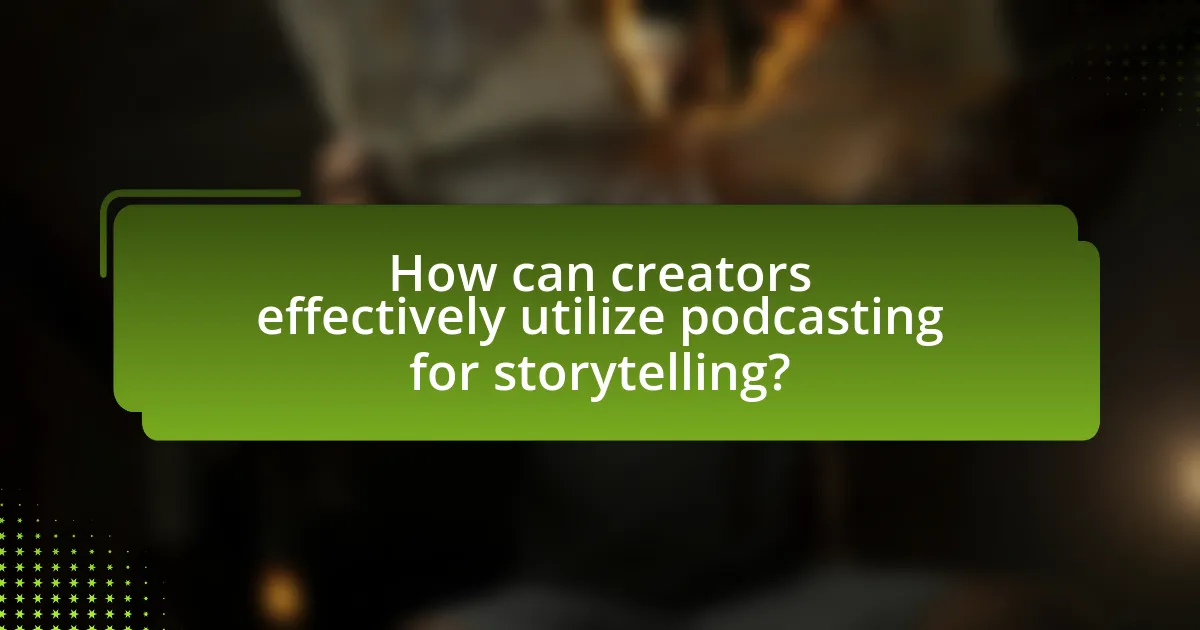
How can creators effectively utilize podcasting for storytelling?
Creators can effectively utilize podcasting for storytelling by leveraging audio’s unique ability to create immersive experiences. This medium allows for the use of sound design, voice modulation, and pacing to enhance narrative engagement. For instance, studies show that storytelling through audio can evoke stronger emotional responses compared to visual media, as listeners often form personal connections with the narrator’s voice. Additionally, incorporating interviews, sound effects, and music can enrich the storytelling experience, making it more dynamic and relatable. Research indicates that podcasts with well-structured narratives and compelling characters can significantly increase listener retention and engagement, demonstrating the effectiveness of this medium in modern storytelling techniques.
What best practices should be followed for effective podcast storytelling?
Effective podcast storytelling requires a clear narrative structure, engaging content, and a strong emotional connection with the audience. A well-defined narrative structure, such as the classic three-act format, helps listeners follow the story easily and maintain interest. Engaging content, including vivid descriptions and relatable characters, enhances the storytelling experience, making it more immersive. Additionally, establishing an emotional connection through personal anecdotes or relatable themes fosters listener engagement and retention. Research indicates that podcasts with strong storytelling elements can increase listener loyalty and satisfaction, as evidenced by a study from Edison Research, which found that 75% of podcast listeners feel more connected to the content when it tells a compelling story.
How can creators engage their audience through narrative techniques?
Creators can engage their audience through narrative techniques by employing storytelling elements such as character development, emotional arcs, and immersive world-building. These techniques foster a connection between the audience and the content, making the narrative relatable and compelling. For instance, character development allows listeners to identify with protagonists, while emotional arcs create a journey that resonates on a personal level. Research indicates that narratives with strong emotional engagement can increase listener retention by up to 70%, demonstrating the effectiveness of these techniques in maintaining audience interest.
What tools and resources are available for aspiring podcast storytellers?
Aspiring podcast storytellers can utilize a variety of tools and resources to enhance their craft. Essential tools include audio recording software like Audacity and Adobe Audition, which allow for high-quality sound editing and production. Additionally, platforms such as Anchor and Podbean provide hosting services that simplify the distribution of podcasts. Resources like online courses from platforms such as Coursera and Skillshare offer training in storytelling techniques and audio production. Furthermore, communities on social media and forums like Reddit provide networking opportunities and feedback from fellow podcasters. These tools and resources collectively support the development of effective storytelling in podcasting.
What challenges do storytellers face in the podcasting medium?
Storytellers face several challenges in the podcasting medium, including competition for audience attention, technical production quality, and the need for effective engagement strategies. The podcasting landscape is saturated, with over 2 million active podcasts as of 2023, making it difficult for individual storytellers to stand out. Additionally, high production standards are essential; poor audio quality can lead to listener drop-off, as studies show that 80% of listeners abandon a podcast due to subpar sound. Furthermore, storytellers must develop compelling narratives that maintain listener interest over time, as audience retention is crucial for success in this medium.
How can creators overcome common obstacles in podcast storytelling?
Creators can overcome common obstacles in podcast storytelling by employing structured planning, utilizing effective editing techniques, and engaging with their audience. Structured planning involves outlining episodes to ensure a coherent narrative flow, which helps in maintaining listener interest. Effective editing techniques, such as removing unnecessary content and enhancing audio quality, can significantly improve the overall listening experience. Engaging with the audience through feedback and incorporating their suggestions can also help creators refine their storytelling approach, making it more relatable and impactful. These strategies are supported by industry practices that emphasize the importance of clarity and connection in audio storytelling.
What strategies can be employed to maintain listener interest?
To maintain listener interest, podcasters can employ strategies such as storytelling techniques, audience engagement, and varied pacing. Storytelling techniques, including the use of compelling narratives and relatable characters, keep listeners emotionally invested. Audience engagement can be enhanced through interactive elements like Q&A sessions or listener feedback, which fosters a sense of community. Additionally, varying pacing—alternating between fast-paced segments and slower, reflective moments—can help sustain attention by creating dynamic listening experiences. Research indicates that podcasts that incorporate these strategies tend to have higher listener retention rates, as they cater to diverse audience preferences and maintain a stimulating auditory environment.
What are the future trends in podcasting and storytelling?
Future trends in podcasting and storytelling include increased interactivity, personalized content, and the integration of augmented reality (AR) and virtual reality (VR) elements. Interactivity allows listeners to engage with content through polls and feedback, enhancing their experience. Personalized content, driven by algorithms, tailors stories to individual preferences, making them more relevant and engaging. The integration of AR and VR is expected to create immersive storytelling experiences, allowing audiences to experience narratives in a more engaging and participatory manner. According to a report by Edison Research, 55% of Americans have listened to a podcast, indicating a growing audience that is likely to seek innovative storytelling formats.
How might emerging technologies influence podcast storytelling?
Emerging technologies significantly influence podcast storytelling by enhancing interactivity and personalization. For instance, advancements in artificial intelligence enable creators to tailor content to individual listener preferences, thereby increasing engagement. Additionally, immersive audio technologies, such as spatial audio, allow for a more captivating storytelling experience, making listeners feel as if they are part of the narrative. According to a report by Edison Research, 55% of podcast listeners express a desire for more interactive content, indicating a clear demand for innovative storytelling methods. These technologies not only enrich the narrative but also expand the creative possibilities for podcasters, ultimately transforming how stories are told and experienced.
What new storytelling formats are being explored in the podcasting space?
New storytelling formats being explored in the podcasting space include narrative-driven series, immersive audio experiences, and interactive storytelling. Narrative-driven series often utilize serialized formats that allow for deep character development and complex plots, similar to television dramas. Immersive audio experiences leverage sound design and spatial audio techniques to create a more engaging environment for listeners, enhancing emotional connection to the story. Interactive storytelling incorporates audience participation, allowing listeners to influence the direction of the narrative through choices or feedback, which has been shown to increase engagement and investment in the content. These formats reflect a shift towards more dynamic and participatory storytelling methods in the podcasting medium.
What practical tips can enhance storytelling in podcasts?
To enhance storytelling in podcasts, creators should focus on structuring narratives with a clear beginning, middle, and end. This structure helps listeners follow the story and maintain engagement. Additionally, incorporating sound design, such as music and sound effects, can evoke emotions and create a more immersive experience. Research indicates that well-placed audio elements can increase listener retention by up to 30%. Furthermore, using personal anecdotes and relatable characters can foster a connection with the audience, making the story more impactful. Engaging with listeners through questions or prompts encourages interaction and investment in the narrative.

